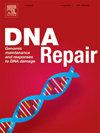靶向DNA损伤传感器用于癌症治疗
IF 2.7
3区 生物学
Q2 GENETICS & HEREDITY
引用次数: 0
摘要
DNA损伤有内源性和外源性两种来源,DNA损伤剂是癌症治疗的主要手段。DNA损伤传感器(DDS)是一种识别并结合由DNA直接损伤或复制应激引起的独特DNA结构的蛋白质,是DNA损伤反应(DDR)的第一步。DNA损伤传感器负责招募传递下游DNA修复途径信号的换能器蛋白。作为起始蛋白,DDS是抑制DDR激活的抗癌药物的极好候选物。在这里,我们回顾了四个主要的DDS: PARP1, RPA, Ku和MRN复合体。在分析DNA损伤感知的结构机制之前,我们简要介绍了细胞DDS的功能。最后,我们研究了抑制每种DDS用于抗癌治疗的现状,并广泛讨论了DDS靶向的治疗潜力。本文章由计算机程序翻译,如有差异,请以英文原文为准。
Targeting DNA damage sensors for cancer therapy
DNA damage occurs from both endogenous and exogenous sources and DNA damaging agents are a mainstay in cancer therapeutics. DNA damage sensors (DDS) are proteins that recognize and bind to unique DNA structures that arise from direct DNA damage or replication stress and are the first step in the DNA damage response (DDR). DNA damage sensors are responsible for recruiting transducer proteins that signal downstream DNA repair pathways. As the initiating proteins, DDS are excellent candidates for anti-cancer drug targeting to limit DDR activation. Here, we review four major DDS: PARP1, RPA, Ku, and the MRN complex. We briefly describe the cellular DDS functions before analyzing the structural mechanisms of DNA damage sensing. Lastly, we examine the current state of the field towards inhibiting each DDS for anti-cancer therapeutics and broadly discuss the therapeutic potential for DDS targeting.
求助全文
通过发布文献求助,成功后即可免费获取论文全文。
去求助
来源期刊

DNA Repair
生物-毒理学
CiteScore
7.60
自引率
5.30%
发文量
91
审稿时长
59 days
期刊介绍:
DNA Repair provides a forum for the comprehensive coverage of DNA repair and cellular responses to DNA damage. The journal publishes original observations on genetic, cellular, biochemical, structural and molecular aspects of DNA repair, mutagenesis, cell cycle regulation, apoptosis and other biological responses in cells exposed to genomic insult, as well as their relationship to human disease.
DNA Repair publishes full-length research articles, brief reports on research, and reviews. The journal welcomes articles describing databases, methods and new technologies supporting research on DNA repair and responses to DNA damage. Letters to the Editor, hot topics and classics in DNA repair, historical reflections, book reviews and meeting reports also will be considered for publication.
 求助内容:
求助内容: 应助结果提醒方式:
应助结果提醒方式:


